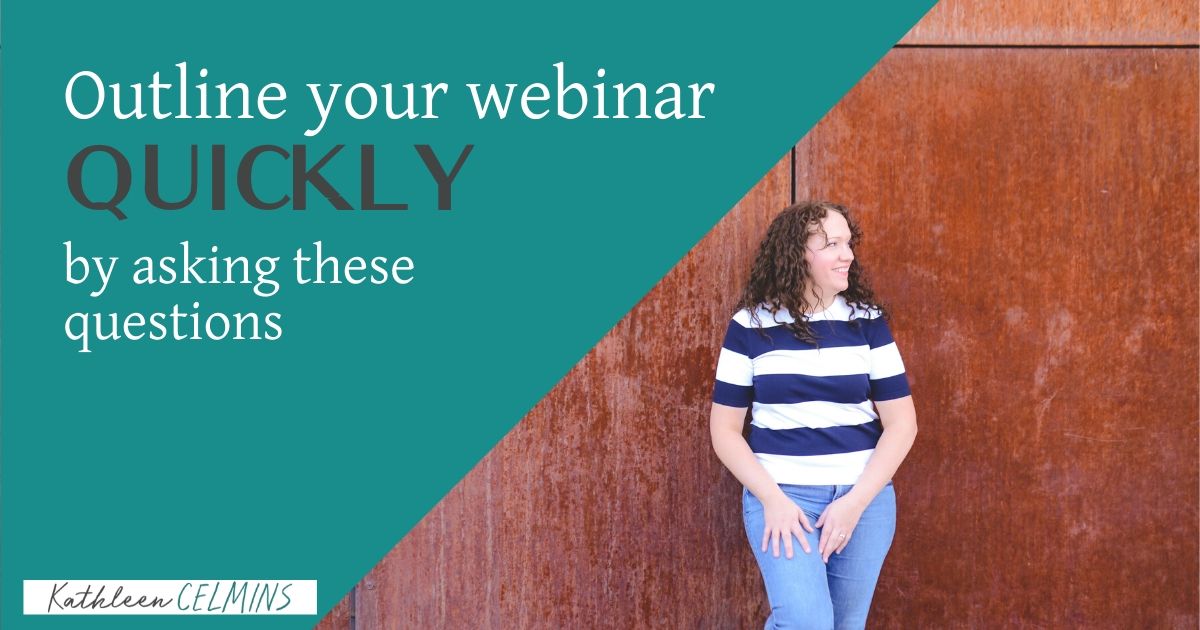This month we are talking about webinars because webinars are a really good way to show people that you know what you’re talking about.
Sometimes the fear of a blank PowerPoint document is far, far worse than a blank on a Word document. If you open PowerPoint and just freeze, this is for you. It’s actually not that hard once you know the questions to ask.
I have a whole list of questions that once they’re answered, all it takes is turning them into slides.
Webinar formats are mostly the same
Most webinars follow a very similar format and layout. You can think about a webinar like a three-legged stool. The balance is very important. If one of the legs of the stool is too long, or too short, your stool is broken – and so is your webinar.
The three legs of your webinar stool are Transformation, Teaching, and Transaction. If you get it right, it’s a 30/40/30 ratio.
The Transformation you’re offering is the first 30%, your Teaching is the next 40%, the Transaction is the last 30%.
These are the first two questions you should be asking before you put together your webinar:
- What’s the goal? Are you gonna push them toward a course a consultation? What do you want them to do?
- What’s it about? We talked here about how to come up with a great webinar topic.
The next part is the steps and mistakes.
If your training goes into a number of steps of a process, then list those out: X amount of steps, Y amount of mistake, Z things. This is going to be a process, a checklist, or an outline.
What’s the promise?
What can your attendees reasonably expect after they’ve watched the webinar? What are they going to learn even if they don’t buy whatever it is you’re asking them to buy.
We want to make sure that this isn’t just an hour-long sales pitch. You need to have some sort of nugget of something that they can take away, which makes it worthwhile to sit in front of a computer listening. Make sure you have access to your testimonials because those go a long way to helping the whole thing go a little more smoothly.
Where your attendees are right now?
- What does the before makeover picture look like?
- Where are their frustrations?
- What are the things they’re frustrated about that you can help them with?
They don’t yet have your offer, so they’re in that before picture of any transformation story. What does that look like for your audience?
What does it look like after the transformation?
- Where are they going?
- What do they want?
- What do they want that your offer to provide?
Often this is something they’re gaining. Sometimes it can also be what they are losing – in the Wellness industry it might be something like losing weight. In business a lot of the time it’s gaining time, saving money, or making more money.
Really distill their frustrations and desires.
The top frustration that people can name is symptoms of the problem, not the problem itself. What is the real problem that your offer solves? What do your people really want?
And now, way down here, let’s talk about you who you are.
What’s your title? Maybe share some top-line LinkedIn stuff that shows your audience that you know what you’re talking about – the resume points that make a difference. Don’t spend too much time on this, they’re not here for you. They’re here for themselves. So lead right away into why what you’re teaching is important.
They are still deciding whether to stick around so give them three or four reasons why they should stick around.
And talk about your peers.
What are the other people in your field, the so-called experts, the guru’s, what are they doing that is either wrong or somehow incomplete?
Who are they? I wouldn’t necessarily mention who they are in your live webinar, but write it down in your outline. What are they doing? What are they saying? And how are they wrong? Because that’s going to lead right into how your system is different.
Think about it in terms of what you can offer your audience what they want, what they are looking for. The teaching that you do is intended to lead right into your sales pitch.
The transaction
The transaction piece should be the last thirty percent of your presentation. By focusing on it you avoid the danger of coming online, dumping a whole bunch of information, then saying “okay . . . bye.”
Instead, you need to make sure that you’re building up toward the expectation so that when you lay out the before, and then you get into the high-level overview of how your stuff is different, people are going to want it. The next piece is how to effectively sell on a webinar without actually feeling really sketchy or sleazy or whatever.
If you want to jump onto a strategy session, I would love to and I have some time. You can go to my contact page, and let me know what you’re working on. I would love to give you 15 minutes of my time and help you map out what it is you are going to do for your marketing in 2020.

